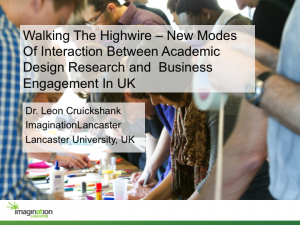This paper describes two co-ordinated initiatives to allow business engagement (working with business on their problems) and academic research to support and build on each other rather than existing in tension.
The disjunction between research and business engagement in academia has its structural roots in the 1950`s where long established Universities were complimented by a network on new ‘Polytechnics’ for more vocational activities. It was in these new institutions that design flourished quite separately from traditional sources of academic research. The disjunction remains, research is seen as higher status than business engagement, this is perpetuated by funding models, promotion opportunities and work-load models, all directing academics away from working with business directly.
Despite recognition for the international excellence in Art and Design research (=3rd in the UK with 100% research of international quality) members of Lancaster Universities design research lab ImaginationLancaster are forging new approaches and activities to erode this hierarchical relationship. We argue that this is vital for research to remain vital and relevant and to have an impact on the real worlds (Sainsbury 2008) but also to advance innovation in business engagement, (Cruickshank 2009).
This paper presents two initiatives Imagination helps to lead, in the first we present a collaboration of academics and business engagement professionals called IDEAS (Mather 2009). IDEAS (Innovation Design Entrepreneurship and Science) draws on research and practice in innovation and design to collaborate with a network of 500 small high technology companies thought the North West of England. Part of this involves the development and application of participative design processes with companies creating highly innovative knowledge exchange activities. E.g. an approach called physical problem solving uses choreography and dance with high-tech company owners to explore the fundamentals of collaboration and invention in the workplace, with well documents and highly positive results.
This innovative real world impact on companies has a reciprocal benefit for research with concepts explored in a much more dynamic iterative cycle than would be possible in a traditional academic context, from this we are developing research into problem solving approaches (nets – not networks) and a new collaborative way of helping companies to think about each other (reverse-benchmarking).
A longer term component to this approach lead to the development of the HighWire doctoral training program. With c. €5 million funding from the UK research councils we have a centre to train 50 PhD students in the next 5 years undertaking interdisciplinary projects crossing between Design, Computing and Management. This 4 year programme is noteworthy for the degree of business involvement. As all the practical components of the first year of the course (a Masters of Research in Digital Innovation) involve collaboration with industrial partners to do research (not consultancy or work experience). This pattern is continued with individual PhD projects.
Through the ongoing IDEAS collaboration and HighWire students growing up as researcher who work with industry as a natural part of their studies we are propagating a model for academia where the distinction between academic research and business engagement becomes irrelevant.

Downloads
Walking the HighWire
Presentation to FISCAR: Activity Theory and Design conference in Helsinki 2010

